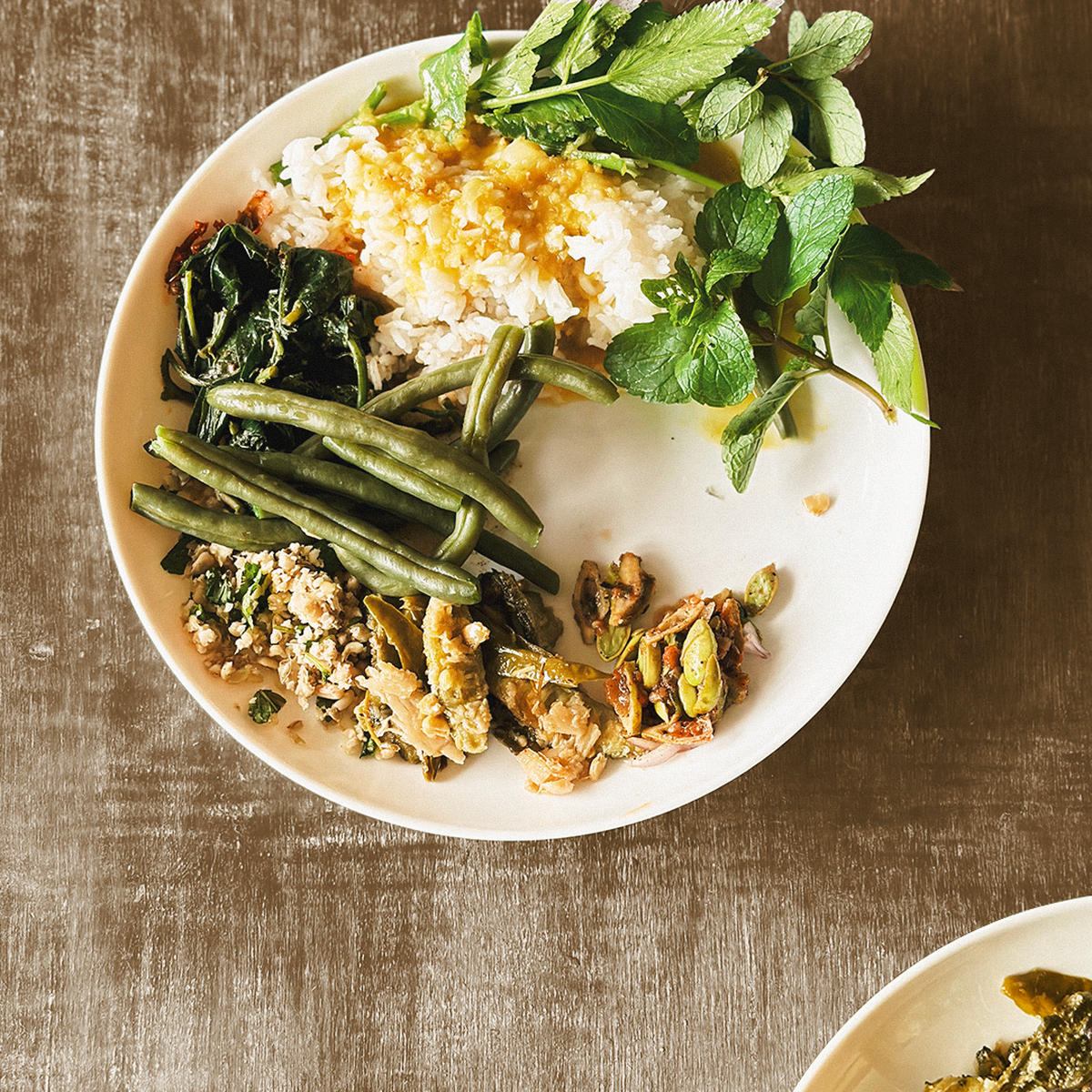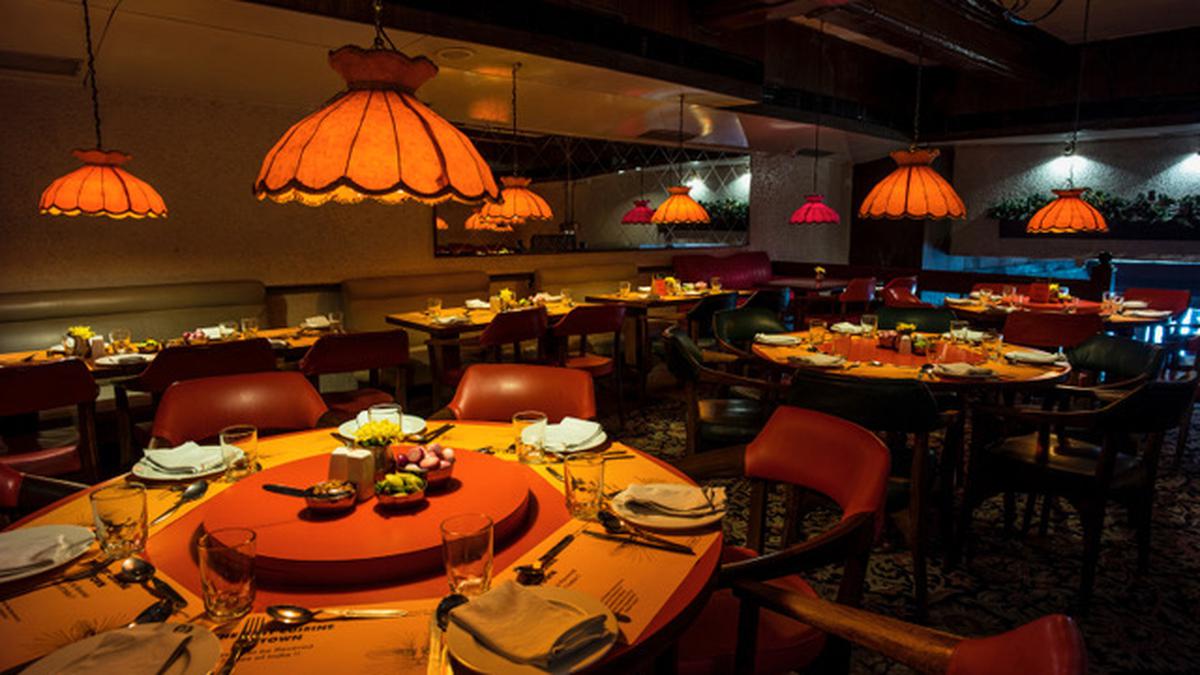It wasn’t until my trip to Nagaland that I truly appreciated the ancient art of foraging, which predates a run to the vegetable market (remember subzi mandi? — yes GenZ, that was a thing) and online grocery shopping. So, there I was, on the side of a road, on our way down the hilltop of Longwa village, looking for my dinner.
I was staying in Mon district and foraging through the villages of Tizit, Longwa, and Chenwetnyu.
After some help, I managed to bag some really delicious stems of knotweed (Hanahahn). And for someone who loves her rasam extra sour, this stem was a revelation. “It is not just about what is growing in our backyards, it is also about what is growing in our sacred forest and our neighbours’ homes,” muses Wungnaothan Zimik, known among friends as Athan, a former banker-turned -chef , who is a veritable trove of Naga folklore and gastronomic secrets passed down by his forefathers.
Athaan (sitting) and Lidang Konyak Kinimi foraging knotweed.
| Photo Credit:
Special Arrangement
“If you ask me in the morning what I will have for lunch, I would not have an answer, because quite often it is what dishes my neighbours have shared with me or what herbs they have foraged and passed on,” he says.
As 37-year-old Athan begins to reminisce about the sacred forest of his childhood, his eyes light up with excitement. “It was a place that provided generously,” he says. “I would often join my elders to forage for food. The village men would howl to signal their departure to the forest early morning, and other villagers would join in.”
He recalls the importance of taking only what was needed and leaving the rest for others. “We always respect the land and its produce,” he says. “If we got hungry, it was okay to pluck a fruit from the neighbour’s land, but we only took enough to satisfy our hunger.”
(Clockwise) Foraged leaves – fish mint, pennywort and mint, and fiddle fig ferns with perilla powder, white naga beans salad with raw ginger and lungrihan, stinky beans salad with Naga king chilli, green beans steamed and wild olive fermented
| Photo Credit:
Special Arrangement
But even in this simple act of foraging, Athan says, his family instilled in him the values of sharing and generosity. He fondly remembers a time when he had picked too much, and his uncle gently reminded him of the importance of leaving some for others. “Eat what you can and leave the rest. When someone else comes next, they can feed themselves if they ever get hungry,” his uncle had said.
Among Naga tribes, altruism and looking out for one another are not just values, but a way of life. Selfishness is disapproved of, and benevolence and devotion are held in high regard. As Athan puts it, “Anyone who acts out of greed is frowned upon in our village. Sharing and looking out for one another is the norm.”
Nagaland has 17 tribes and foraging in tribal communities not only fostered independence and self-sufficiency but also provided access to fresh and nutrient-rich food.
Sourcing ethical ingredients
In recent years, Nagaland has also witnessed a growing interest among travellers, especially chefs, seeking to explore its unique and diverse cuisine. “I’ve been here twice now, solely to source the freshest and most ethical ingredients for my restaurant in Gurugram,” shares Chef Vanshika Bhatia, chef and partner of OMO. Vanshika appreciates the farmers’ pride in avoiding monoculture and enriching the soil with nutrients. She also values the personal relationships she builds with them, which often leads to discovering lesser-known plant parts to incorporate into her dishes.
Chef Vanshika Bhatia of OMO Cafe with a local in Mon district, Nagaland
| Photo Credit:
Special Arrangement
She prepares cuisine inspired by various indigenous communities throughout India, such as Naga, Kodava, Kumaoni, and Garhwali. OMO’s menu gracefully adapts to the seasons, showcasing the freshest produce available while honouring the roots of Indian culinary heritage through modern interpretations.
One such discovery was passion fruit leaves, which have a guava-like flavour. “My appreciation for sirarakhongchilli and axone has also grown through these trips,” notes Vanshika. The vivid crimson colour and versatile taste of sirarakhongchilli makes it a prized ingredient beyond the State’s borders, while the pungent aroma and taste of axone, a fermented soybean delicacy, may trigger a love-hate relationship. Regardless, it is an integral part of Naga cuisine and a must-try for daring food enthusiasts.
While many people assume that Naga cuisine primarily consists of meat, Mon native Grace Muivah explains that “Eighty percent of what you’ll find in a Naga thali at home will be vegetarian,” although bamboo shoots and pork are a staple in any Naga meal.

A Naga thali featuring steamed rice and dal, with a side of mint, steamed beans and roasted stinky beans salad with Naga king chilli
| Photo Credit:
Special Arrangement
Unlike in the mainland, there is no concept of a masala dabba here — food served is flavoured with Naga chillies for spice, tree tomatoes and sumac berries for sourness and Naga spring salt, axone and perilla seeds for a savoury flavour. Sweets are not served usually and the occasional ones would be made with jaggery or sugarcane juice extract. Of course, there are the additions of some dried fish or wild mushrooms to add that umami zing.
Community farming
About 73% of the people in Nagaland depend on agriculture, with Mon district engaging in community farming to grow a variety of crops including rice, corn, millets, sugarcane, tubers, coffee, and everyday herbs that are foraged or grown in backyards.
Anouk Wangsa with his coffee beans
| Photo Credit:
Special Arrangement
Grace, who runs Ngarum coffee in OMO cafe, Gurugram, is also exploring Nagaland for ingredients, specifically Arabica coffee beans. She finally finds them on a small trek where Anouk Wangsa, 32, a Konyak tribe member, and over 30 other farmers grow coffee shrubs under tall wild fruit trees in the deep jungle. “While it grows in different districts of the State, we source it specifically from Mon as they are all nano-lots,” she explains. Nano lot refers to coffee sourced from a single, specially-tended plot of land at a single farm.
With his eyes glued to the lush surroundings of Nagaland, Delhi-based pastry chef Adarsh Mishra’s notebook is quickly filling up with ideas. “For me, foraging is like a treasure hunt, and every ingredient I discover sparks my imagination for the next big recipe,” the 27-year-old says.
The writer was in Nagalnd on invitation of OMO cafe in Gurugram.
.
Pork, the staple meat
Meat, especially pork, is a staple protein source in Naga cuisine, and smoking it over a wood fire is a popular way to add flavour. Smoked meat is used in a variety of dishes, including stews, curries, and chutneys. Slaughtering a pig is a part of any Naga celebration, and all parts of the pig are used in food preparation. Extra meat is distributed among neighbours or preserved, reflecting a strong sense of shared living and respect for food. “Nothing goes to waste here. We also enjoy local chicken stew a lot. It’s great nourishment for new moms and people recovering from illness,” shares Lidang Konyak Kinimi, a popular food blogger and native of Mon district in Nagaland. In fact, Lidang reveals a tradition in her tribe of visiting new moms with live chickens, so that they can feast on them to recover and gain strength faster post-delivery.








